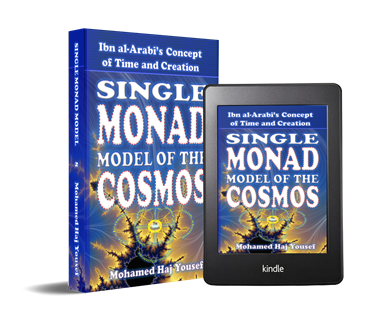The Single Monad Model
See also Amazon reviews for this book and other reviews page.
View on
Google Books, or scroll down to Preview.
 Ibn Arabi is the only scholar who was able to formulate a unique cosmological model that is capable of explaining our observations as well as many phenomena in physics and cosmology, and even solve some perplexing modern and historical riddles in science and philosophy such as the EPR paradox and Zeno paradoxes of motion.
Moreover, the Single Monad Model explains for the first time in history the importance of the “week” as a basic unit of space and time together. This prodigious theory is based on the notion of the intertwining days where Ibn Arabi shows that at every instance of time there is indeed one full week of creation that takes place in the globe.
Ibn Arabi is the only scholar who was able to formulate a unique cosmological model that is capable of explaining our observations as well as many phenomena in physics and cosmology, and even solve some perplexing modern and historical riddles in science and philosophy such as the EPR paradox and Zeno paradoxes of motion.
Moreover, the Single Monad Model explains for the first time in history the importance of the “week” as a basic unit of space and time together. This prodigious theory is based on the notion of the intertwining days where Ibn Arabi shows that at every instance of time there is indeed one full week of creation that takes place in the globe.
As we discuss in the opening chapter, there is no doubt that time is one of the most important issues in physics, cosmology, philosophy and theology, and hundreds of books and articles have been published in these fields. However, none of these studies have fully developed Ibn 'Arabî's unique view of time in its cosmological dimensions, although his conception of time is indeed central to understanding, for example, his controversial theory of the 'oneness of being'. One possible reason for this relative neglect is the difficult symbolic language he usually used. Also, he didn't discuss this subject at length in any single place in his extant works--not even in chapters 59, 291 and 390 of the Futûhât whose titles relate directly to time--so we must piece together his overall cosmological understanding of time from his scattered treatments in many works and different contexts within his magnum opus, the Futûhât, and other books. Therefore this book may be considered the first comprehensive attempt to set forth all the relevant dimensions of time in Ibn 'Arabî's wider cosmology and cosmogony.

To start with, Ibn 'Arabî considers time to be a product of our human 'imagination', without any real, separately existing entity. Nevertheless, he still considers it to be one of the four main constituents of existence. We need this imagined conception of 'time' to chronologically arrange events and what for us are the practically defining motions of the celestial orbs and other physical objects, but for Ibn 'Arabî, real existence is attributable only to the actually existing thing that moves, not to motion nor to time (nor space) in which this motion is observed. Thus Ibn 'Arabî distinguishes between two kinds of time: natural and para-natural, and he explains that they both originate from the two forces of the soul: the active force and the intellective force, respectively. Then he explains that this imaginary time is cyclical, circular, relative, discrete and inhomogeneous. Ibn 'Arabî also gives a precise definition--drawing on the specific usage of the Qur'an and earlier Arab conceptions of time--of the day, daytime and night, showing how these definitions are related to the relative motions of the celestial orbs (including the earth), where every orb has its own 'day', and those days are normally measured by our normal observable day that we count on the earth.
 The Duality of Time Theory, that results from the Single Monad Model, explains how multiplicity is dynamically emerging from absolute Oneness, and vice versa, at every instance of time! This theory leads to the Ultimate Symmetry of space and its instantaneous breaking into the physical and psychical creations, with two hyperbolically orthogonal arrows of time. This will explain super-symmetry and matter-antimatter asymmetry, in addition to uniting the principles of Relativity and Quantum theories, as well as the psychical and spiritual domains; all based on the same genuinely-complex time-time geometry that provides the smooth link between physical particles and absolute homogeneous Euclidean space, via four distintive levels of symmetry, in addition to original level of absolute Oneness.
The Duality of Time Theory, that results from the Single Monad Model, explains how multiplicity is dynamically emerging from absolute Oneness, and vice versa, at every instance of time! This theory leads to the Ultimate Symmetry of space and its instantaneous breaking into the physical and psychical creations, with two hyperbolically orthogonal arrows of time. This will explain super-symmetry and matter-antimatter asymmetry, in addition to uniting the principles of Relativity and Quantum theories, as well as the psychical and spiritual domains; all based on the same genuinely-complex time-time geometry that provides the smooth link between physical particles and absolute homogeneous Euclidean space, via four distintive levels of symmetry, in addition to original level of absolute Oneness.
Preview on Google Books
... between physical particles and absolute homogeneous Euclidean space, via four distintive levels of symmetry, in addition to original level of absolute Oneness. Preview on Google Books ...
... ive motions of the celestial orbs (including the earth), where every orb has its own 'day', and those days are normally measured by our normal observable day that we count on the earth. The Duality of Time Theory , that results from the Single Monad Model , explains how multiplicity is dyn ...
... Single Monad Model See also Amazon reviews for this book and other reviews page . View on Google Books , or scroll down to Preview. Ibn Arabi is the only scholar who was able to formulate a UNIQUE COSMOLOGICAL model that is capable of explaining our observations as well as many phenomena i ...
... in science and philosophy such as the EPR paradox and Zeno paradoxes of motion. Moreover, the Single Monad Model explains for the first time in history the importance of the “week” as a BASIC UNIT of space and time together. This prodigious theory is based on the notion of the intertwi ...
... ficult symbolic language he usually used. Also, he didn't discuss this subject at length in any single place in his extant works--not even in chapters 59, 291 and 390 of the Futûhât whose TITLES RELATE directly to time--so we must piece together his overall cosmological understanding of ...
... s extant works--not even in chapters 59, 291 and 390 of the Futûhât whose titles relate directly to time--so we must piece together his overall cosmological understanding of time from his SCATTERED TREATMENTS in many works and different contexts within his magnum opus, the Futûhât, and ...
... neness of being'. One possible reason for this relative neglect is the difficult symbolic language he usually used. Also, he didn't discuss this subject at length in any single place in his EXTANT WORKS --not even in chapters 59, 291 and 390 of the Futûhât whose titles relate directly to ...
... ial theory of the 'oneness of being'. One possible reason for this relative neglect is the difficult symbolic language he usually used. Also, he didn't discuss this subject at length in any SINGLE PLACE in his extant works--not even in chapters 59, 291 and 390 of the Futûhât whose titles ...
... showing how these definitions are related to the relative motions of the celestial orbs (including the earth), where every orb has its own 'day', and those days are normally measured by our NORMAL OBSERVABLE day that we count on the earth. The Duality of Time Theory , that results from the ...
... any real, separately existing entity. Nevertheless, he still considers it to be one of the four main constituents of existence. We need this imagined conception of 'time' to chronologically ARRANGE EVENTS and what for us are the practically defining motions of the celestial orbs and other ...
... gives a precise definition--drawing on the specific usage of the Qur'an and earlier Arab conceptions of time--of the day, daytime and night, showing how these definitions are related to the RELATIVE MOTIONS of the celestial orbs (including the earth), where every orb has its own 'day', and ...
... ining our observations as well as many phenomena in physics and cosmology, and even solve some perplexing modern and historical riddles in science and philosophy such as the EPR paradox and Zeno paradoxes of motion. Moreover, the Single Monad Model explains for the first time in history th ...











